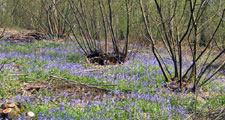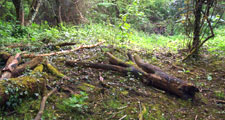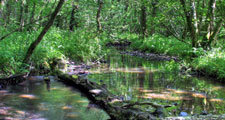Managing Native Woodlands
The Need for Management
Many of the county’s native woods have not been systematically managed for many years. In some cases neglect has allowed natural processes to create habitats of considerable value. In other cases the selective felling of timber species, overgrazing by livestock, or the introduction of non-natives (either deliberately or through the colonisation of woods damaged by Dutch Elm Disease) has diminished their ecological value or their productivity.
Historically most of the county’s woodlands would have been managed either as coppice, wood pasture or high forest subject to selective felling under shelterwood or group felling systems. In the industrial period the demand for pit-wood and competition from coal as a fuel led to coppice systems being abandoned and some woodlands being clear-felled and replanted. In the twentieth century some woodlands were felled during the first and second world wars and abandoned to regenerate naturally. Later in the century others were felled and replanted with commercial species.
The management of native woods today should aim either to maintain the natural conditions of ‘wild’ woodland through minimal intervention, or the semi-natural conditions created by traditional forms of management – high forest, coppice or wood-pasture. Heavily modified or replanted native woods may need more active restoration.
Published Guidance
The Forestry Commission has published guidance on managing semi-natural woodlands as part of The UK Forestry Standard (Standard Note 5) together with a series of detailed Practice Guides on the management of a range of different types of semi-natural woodlands. Some of these can be downloaded from the Forestry Commission website.
General Principles
- Get to know the wood. Observe and map its physical characteristics, variations in slope, drainage, aspect and soils, the structure of its canopy and understorey, and the composition of its ground flora. Identify relic features like veteran trees, woodbanks, charcoal hearths and trackways.
- Find out as much as you can about its history and ecology. The County Ecologist and Durham Wildlife Trust may have information on its flora and fauna, and the County Archaeologist and local history societies on its historical interest.
- Find out if there are any Designated Landscapes – SSSI, County Wildlife Sites, Scheduled Ancient Monuments, Conservation Area, Tree Preservation Orders etc – that might affect how the woodland needs to be managed.
- Find out about any protected species that may be affected by operations (particularly bats and red squirrel). Contact specialist groups if necessary.
- Take advice. The Forestry Commission provide advice, grants and useful publications on managing native woods. They can also recommend specialists for carrying out more detailed assessments. A Woodland Assessment Grant may be available to help you undertake assessments of ecological, landscape, historical and cultural factors and for community involvement.
- Consider the interests of local communities. Many ancient woodland sites are places of local folklore and tradition and may contain features of value to local communities.
- Draw up a management plan and monitor its implementation.
- Minimise intervention generally and only carry out management works where you have specific objectives – doing nothing is often a valid option.
- Maintain semi-natural woodland types. Management should be tailored to those present in the wood.
- Maintain or restore diversity of structure. A range of age classes is generally preferable to even-aged stands.
- Maintain or restore species diversity. Reintroduce important species characteristic of the native woodland types if they have been lost to selective felling or grazing.
- Maintain diversity of habitats within and around the wood and particularly features like open glades and wetlands. When creating or restoring areas of open space relate it to wetlands, watercourses, rides, outcrops and cultural features.
- Maintain a mature habitat. Retain old trees, and dying and diseased trees where it is safe to do so, along with standing and fallen deadwood.
- Minimise the scale and pace of change – wildlife takes time to adjust.
- Use low impact felling and extraction techniques. Extraction along established rides, with low ground pressure vehicles or with horses can help minimise damage to sensitive ground flora.
- Remove non-native species progressively unless, like Rhododendron, they are causing specific problems.
- Prevent excessive browsing by deer, rabbits or hares, particularly when restocking
- Use natural regeneration where possible for restocking. When planting is necessary use the appropriate species for the native woodland types present on site, and use plant material of local origin or from the nearest FC Seed Zone. Plant in irregular patterns influenced by variations in soils, landform and vegetation, and vary the spacing to create a varied woodland structure.
- Preserve historical features like ancient rides, woodbanks, charcoal pits and archaeological features and keep them clear of planting or natural regeneration.
- Look to areas surrounding the woodland for opportunities to extend it, or manage them sensitively to compliment the woodland habitat – for example by creating conservation headlands around arable fields, or restoring hedgerows to improve connectivity.
Coppice
Some native woodlands in the county show evidence of having been managed as coppice in the past. Coppicing on a regular cycle can create conditions favourable to certain species and particularly spring flowering plants like bluebell, primrose and celandine, and some species of butterfly. Restoring neglected coppice can be of benefit to those species in the right circumstances but may also be damaging to established shade and moisture-loving flora and fauna where coppicing cycles have been abandoned for a long time. Reinstatement of coppicing regimes may only be appropriate where:
- The underwood was coppiced within the last 50 years or so and has sufficient vigour to respond to coppicing.
- The wood is large enough (>5Ha) to contain practical compartments of different ages.
- Coppicing on a regular cycle can be sustained in the future.
- The flora and fauna present on site would benefit from the conditions created by coppicing.
- Grazing by livestock and browsing by deer can be controlled.
Coppicing small areas within a wood managed as high forest – particularly along rides or margins – can be a useful way of retaining a cycle of habitats or creating structural diversity.
Wood Pasture
Wood pasture is woodland that has traditionally been grazed, resulting in a mosaic of habitats – woodland, grassland or heathland – often with veteran open grown or high forest trees.
Wood pastures are very variable in character and include ancient deer parks, ornamental parklands, winter-grazed woodlands in the uplands, juniper woods and more recent encroachments of woodland onto heath and pasture. The oldest wood pastures are generally the most biologically diverse and often support a rich invertebrate population. Younger, or less diverse, wood pastures may still have value and can be particularly important for species like Black Grouse and Nightjar.
Grazing in woodlands – whether by livestock, deer or rabbits – can suppress or destroy the natural ground flora, damage mature trees, and prevent natural regeneration. At high levels it can seriously reduce the ecological value of a woodland and may ultimately lead to its disappearance. It is a particular threat to small woodlands and should generally be controlled. Removing grazing from established wood pasture, however, leads to regeneration as young woodland, and a decline in habitat diversity. The decision to exclude stock from a grazed woodland or to re-introduce livestock to a formerly grazed woodland needs to be taken carefully and will depend on a number of factors, and in particular whether:
- The site has a long history as wood pasture.
- The ground flora is dominated by species suited to open conditions.
- Grazing would clearly be of benefit to rare or important species present on site or in the locality.
- Grazing levels would not prejudice the long-term survival of the woodland component.
In most cases it would be useful to take specialist advice from the Forestry Commission or DEFRA.



